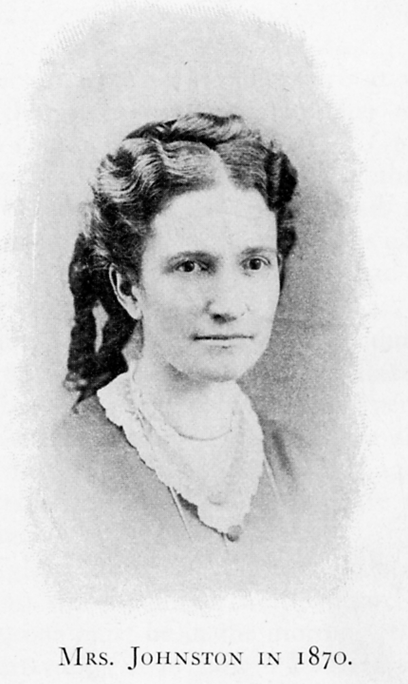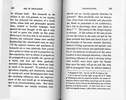The Struggle for a College Education
Teacher and Professor
In 1862, two events occurred at Kinsman Academy which influenced Mrs. Johnston's life thereafter. It was where she met Dr. Allen, chairman of the Kinsman Academy Board of Trustees, and his wife, thus beginning a lifelong friendship with the Allen family that eventually spanned five generations. Kinsamn was also the place where Mrs. Johnston learned that she “would rather teach than do anything else in the world.”
Several years after her husband's death, Johnston inherited a small sum that she used to pursue two lifelong ambitions: she studied Latin for a year and then traveled to France and Germany where she studied French and German. She fell in love with European art and architecture.
Adelia Johnston returned to Oberlin in 1870 and was offered a position as “Principal of the Ladies Department,” which was an administrative position. She refused the offer unless she was allowed to teach, even though at the time a female professor instructing male students was unheard of. Oberlin agreed and she started as Professor of History in 1870, the first female professor at Oberlin and, at the age of 33, also the youngest. At the time co-educational colleges were still a rarity so it is likely she was also the first female with full faculty standing at any co-educational institution in the United States.
Coeducation = Sterilization?: Adelia Johnston Confronts a Major Controversy
Coeducation appeared dangerous to 19th century Americans who generally believed the stress of college would cause women a variety of health problems. Dr. Edward H. Clarke (emeritus, Harvard Medical School) supported this idea in Sex in Education, or A Fair Chance for the Girls (Boston: Osgood & Co., 1873). Clarke writes, “What the co-education of the sexes really means [is] degenerations, weaknesses, and sacrifices of noble lives.”
Clarke posited the complex female reproductive system requires more “bodily resources” to develop than the comparatively simple male reproductive system. Thus the demands of higher education would deprive the maturing female reproductive system:
“This delicate and complex mechanism is liable to be aborted or deranged by the withdrawal of force that is needed for its construction and maintenance.”
Clarke argued that once the reproductive system is developed women’s bodies are similarly strained during menstruation so even adult women dare not risk the rigors of higher education.
Dr. Clarke relates anonymous reports of the disastrous long term health of female graduates from coeducational colleges but as a scientist he desires firmer evidence:
"Two or three generations, at least, of the female college graduates of this sort of co-education must come and go before any sufficient idea can be formed of the harvest it will yield. The physiologist dreads to see the costly experiment tried. The urgent reformer, who cares less for human suffering than for the trial of his theories, will regard the experiment with equanimity if not with complacency."
Adelia Johnston’s essay in The Education of American Girls (New York, Putnam: 1874) responds to Dr. Clarke theories and provides the requested data, demonstrating an equal survival rate for men and women from two generations of Oberlin graduates. But what about their quality of life? “How many are hopeless invalids, dragging out ‘tedious days and still more tedious nights’?“ she asked, quoting Clarke. For an answer she surveyed the women of the class of 1856 and provided a summary. Each woman is listed with a brief description of their general health. She confidently concludes the data reveals nothing to frighten “even a physiologist.”
A Woman, a Christian, and a Scholar?
Could the three co-exist? With difficulty if women may not speak publicly. Oberlin’s devout founders knew Paul’s directive:
Let your women keep silence in the churches: for it is not permitted unto them to speak; but they are commanded to be under obedience as also saith the law. 1 Corinth. 14:34, KJV
Thus in 1870 Oberlin had an unwritten rule: women may not speak to “mixed” (male and female) audiences. In the “mixed” classroom female students had their required daily recitations read by the male professor, thereby avoiding public speaking.
A gifted orator and devout Christian Adelia Johnston confronted this rule soon after her appointment. Unexpectedly asked to address a “mixed” audience in another town and uncertain what to do, she slipped out and ran away. Later, describing her embarrassment to President Fairchild, she asked for clarification. Fairchild replied that his observation and experience had convinced him that most women knew a great many things that it would do men good not only to hear but to heed, and so far as he could speak for the College any woman who had anything to say and could find anybody to listen was a liberty to say it.
Though not all supported Fairchild’s decision the “rule” was officially dropped.
In 1906 Mrs. Johnston’s contributions were recognized by an honorary degree from Western Reserve University. Johnson was herself dissatisfied with her education, not because it was too strenuous, but rather because her mother insisted she enroll in the Ladies Course (offered only to women) rather than pursuing a Bachelor’s degree. Adelia Johnston’s years after Oberlin were spent addressing this gap in her education.




